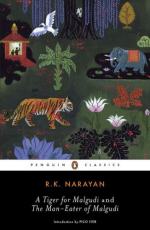|
This section contains 369 words (approx. 1 page at 400 words per page) |

|
The Man-Eater of Malgudi has been interpreted in two different ways: as an allegory of good and evil, and as a study in identification and displacement. Readings of the work as an allegory focus on the relationship between the narrator Nataraj, the passive and well-meaning printer of the town of Malgudi, and Vasu, the eccentric taxidermist and out-of-towner who forces his way into Nataraj's attic and uses it to house himself and practice his seemingly grisly profession. In the allegorical view, Narayan represents Indian passivity while Vasu embodies the aggressive forces of modernism poised to threaten and destabilize Indian society. Certainly, Vasu unsettles the whole community and seems to overwhelm everyone with his brusque personality and antisocial tendencies.
This version of the plot of The ManEater of Malgudi derives credibility from the mythological underpinnings of the narrative: Vasu is cast in the novel...
|
This section contains 369 words (approx. 1 page at 400 words per page) |

|




